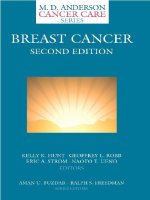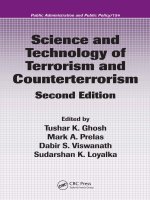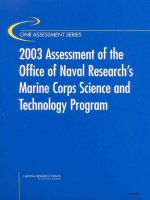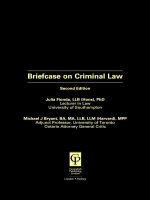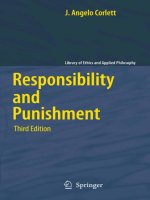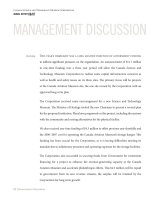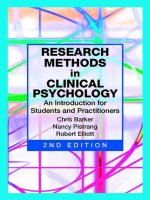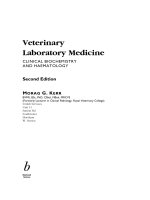Dairy Science and Technology Second Edition doc
Bạn đang xem bản rút gọn của tài liệu. Xem và tải ngay bản đầy đủ của tài liệu tại đây (6.76 MB, 768 trang )
Dairy Science
and Technology
Second Edition
© 2006 by Taylor & Francis Group, LLC
FOOD SCIENCE AND TECHNOLOGY
A Series of Monographs, Textbooks, and Reference Books
Editorial Advisory Board
Gustavo V. Barbosa-Cánovas Washington State University–Pullman
P. Michael Davidson University of Tennessee–Knoxville
Mark Dreher McNeil Nutritionals, New Brunswick, NJ
Richard W. Hartel University of Wisconsin–Madison
Lekh R. Juneja Taiyo Kagaku Company, Japan
Marcus Karel Massachusetts Institute of Technology
Ronald G. Labbe University of Massachusetts–Amherst
Daryl B. Lund University of Wisconsin–Madison
David B. Min The Ohio State University
Leo M. L. Nollet Hogeschool Gent, Belgium
Seppo Salminen University of Turku, Finland
James L. Steele University of Wisconsin–Madison
John H. Thorngate III Allied Domecq Technical Services, Napa, CA
Pieter Walstra Wageningen University, The Netherlands
John R. Whitaker University of California–Davis
Rickey Y. Yada University of Guelph, Canada
76. Food Chemistry: Third Edition,
edited by Owen R. Fennema
77. Handbook of Food Analysis: Volumes 1 and 2,
edited by
Leo M. L. Nollet
78. Computerized Control Systems in the Food Industry,
edited by
Gauri S. Mittal
79. Techniques for Analyzing Food Aroma,
edited by Ray Marsili
80. Food Proteins and Their Applications,
edited by
Srinivasan Damodaran and Alain Paraf
81. Food Emulsions: Third Edition, Revised and Expanded,
edited by
Stig E. Friberg and Kåre Larsson
82. Nonthermal Preservation of Foods,
Gustavo V. Barbosa-Cánovas,
Usha R. Pothakamury, Enrique Palou, and Barry G. Swanson
83. Milk and Dairy Product Technology,
Edgar Spreer
84. Applied Dairy Microbiology,
edited by Elmer H. Marth
and James L. Steele
85. Lactic Acid Bacteria: Microbiology and Functional Aspects,
Second Edition, Revised and Expanded,
edited by
Seppo Salminen and Atte von Wright
© 2006 by Taylor & Francis Group, LLC
86. Handbook of Vegetable Science and Technology: Production,
Composition, Storage, and Processing,
edited by D. K. Salunkhe
and S. S. Kadam
87. Polysaccharide Association Structures in Food,
edited by
Reginald H. Walter
88. Food Lipids: Chemistry, Nutrition, and Biotechnology,
edited by
Casimir C. Akoh and David B. Min
89. Spice Science and Technology,
Kenji Hirasa
and Mitsuo Takemasa
90. Dairy Technology: Principles of Milk Properties and Processes,
P. Walstra, T. J. Geurts, A. Noomen, A. Jellema,
and M. A. J. S. van Boekel
91. Coloring of Food, Drugs, and Cosmetics,
Gisbert Otterstätter
92.
Listeria
, Listeriosis, and Food Safety: Second Edition,
Revised and Expanded,
edited by Elliot T. Ryser
and Elmer H. Marth
93. Complex Carbohydrates in Foods,
edited by Susan Sungsoo Cho,
Leon Prosky, and Mark Dreher
94. Handbook of Food Preservation,
edited by M. Shafiur Rahman
95. International Food Safety Handbook: Science, International
Regulation, and Control,
edited by Kees van der Heijden,
Maged Younes, Lawrence Fishbein, and Sanford Miller
96. Fatty Acids in Foods and Their Health Implications: Second
Edition, Revised and Expanded
, edited by Ching Kuang Chow
97. Seafood Enzymes: Utilization and Influence on Postharvest
Seafood Quality,
edited by Norman F. Haard
and Benjamin K. Simpson
98. Safe Handling of Foods,
edited by Jeffrey M. Farber
and Ewen C. D. Todd
99. Handbook of Cereal Science and Technology: Second Edition,
Revised and Expanded,
edited by Karel Kulp
and Joseph G. Ponte, Jr.
100. Food Analysis by HPLC: Second Edition, Revised and Expanded,
edited by Leo M. L. Nollet
101. Surimi and Surimi Seafood,
edited by Jae W. Park
102. Drug Residues in Foods: Pharmacology, Food Safety,
and Analysis,
Nickos A. Botsoglou and Dimitrios J. Fletouris
103. Seafood and Freshwater Toxins: Pharmacology, Physiology,
and Detection,
edited by Luis M. Botana
104. Handbook of Nutrition and Diet,
Babasaheb B. Desai
105. Nondestructive Food Evaluation: Techniques to Analyze
Properties and Quality,
edited by Sundaram Gunasekaran
106. Green Tea: Health Benefits and Applications,
Yukihiko Hara
107. Food Processing Operations Modeling: Design and Analysis,
edited by Joseph Irudayaraj
108. Wine Microbiology: Science and Technology,
Claudio Delfini
and Joseph V. Formica
109. Handbook of Microwave Technology for Food Applications,
edited by Ashim K. Datta and Ramaswamy C. Anantheswaran
© 2006 by Taylor & Francis Group, LLC
110. Applied Dairy Microbiology: Second Edition, Revised
and Expanded,
edited by Elmer H. Marth and James L. Steele
111. Transport Properties of Foods,
George D. Saravacos
and Zacharias B. Maroulis
112. Alternative Sweeteners: Third Edition, Revised and Expanded,
edited by Lyn O’Brien Nabors
113. Handbook of Dietary Fiber,
edited by Susan Sungsoo Cho
and Mark L. Dreher
114. Control of Foodborne Microorganisms,
edited by Vijay K. Juneja
and John N. Sofos
115. Flavor, Fragrance, and Odor Analysis,
edited by Ray Marsili
116. Food Additives: Second Edition, Revised and Expanded,
edited by A. Larry Branen, P. Michael Davidson, Seppo Salminen,
and John H. Thorngate, III
117. Food Lipids: Chemistry, Nutrition, and Biotechnology: Second
Edition, Revised and Expanded,
edited by Casimir C. Akoh
and David B. Min
118. Food Protein Analysis: Quantitative Effects on Processing,
R. K. Owusu- Apenten
119. Handbook of Food Toxicology,
S. S. Deshpande
120. Food Plant Sanitation,
edited by Y. H. Hui, Bernard L. Bruinsma,
J. Richard Gorham, Wai-Kit Nip, Phillip S. Tong,
and Phil Ventresca
121. Physical Chemistry of Foods,
Pieter Walstra
122. Handbook of Food Enzymology,
edited by John R. Whitaker,
Alphons G. J. Voragen, and Dominic W. S. Wong
123. Postharvest Physiology and Pathology of Vegetables: Second
Edition, Revised and Expanded,
edited by Jerry A. Bartz
and Jeffrey K. Brecht
124. Characterization of Cereals and Flours: Properties, Analysis,
and Applications,
edited by Gönül Kaletunç
and Kenneth J. Breslauer
125. International Handbook of Foodborne Pathogens,
edited by
Marianne D. Miliotis and Jeffrey W. Bier
126. Food Process Design,
Zacharias B. Maroulis
and George D. Saravacos
127. Handbook of Dough Fermentations,
edited by Karel Kulp
and Klaus Lorenz
128. Extraction Optimization in Food Engineering,
edited by
Constantina Tzia and George Liadakis
129. Physical Properties of Food Preservation: Second Edition,
Revised and Expanded,
Marcus Karel and Daryl B. Lund
130. Handbook of Vegetable Preservation and Processing,
edited by
Y. H. Hui, Sue Ghazala, Dee M. Graham, K. D. Murrell,
and Wai-Kit Nip
131. Handbook of Flavor Characterization: Sensory Analysis,
Chemistry, and Physiology,
edited by Kathryn Deibler
and Jeannine Delwiche
© 2006 by Taylor & Francis Group, LLC
132. Food Emulsions: Fourth Edition, Revised and Expanded,
edited by Stig E. Friberg, Kare Larsson, and Johan Sjoblom
133. Handbook of Frozen Foods,
edited by Y. H. Hui, Paul Cornillon,
Isabel Guerrero Legarret, Miang H. Lim, K. D. Murrell,
and Wai-Kit Nip
134. Handbook of Food and Beverage Fermentation Technology,
edited by Y. H. Hui, Lisbeth Meunier-Goddik, Ase Solvejg Hansen,
Jytte Josephsen,
Wai-Kit Nip, Peggy S. Stanfield, and Fidel Toldrá
135. Genetic Variation in Taste Sensitivity,
edited by John Prescott
and Beverly J. Tepper
136. Industrialization of Indigenous Fermented Foods: Second Edition,
Revised and Expanded,
edited by Keith H. Steinkraus
137. Vitamin E: Food Chemistry, Composition, and Analysis,
Ronald Eitenmiller and Junsoo Lee
138. Handbook of Food Analysis: Second Edition, Revised
and Expanded, Volumes 1, 2, and 3,
edited by Leo M. L. Nollet
139. Lactic Acid Bacteria: Microbiological and Functional Aspects:
Third Edition, Revised and Expanded,
edited by Seppo Salminen,
Atte von Wright, and Arthur Ouwehand
140. Fat Crystal Networks,
Alejandro G. Marangoni
141. Novel Food Processing Technologies,
edited by
Gustavo V. Barbosa-Cánovas, M. Soledad Tapia,
and M. Pilar Cano
142. Surimi and Surimi Seafood: Second Edition,
edited by
Jae W. Park
143. Food Plant Design,
edited by Antonio Lopez-Gomez;
Gustavo V. Barbosa-Cánovas
144. Engineering Properties of Foods: Third Edition,
edited by
M. A. Rao, Syed S.H. Rizvi, and Ashim K. Datta
145. Antimicrobials in Food: Third Edition,
edited by
P. Michael Davidson, John N. Sofos, and A. L. Branen
146. Encapsulated and Powdered Foods,
edited by Charles Onwulata
147. Dairy Science and Technology: Second Edition,
Pieter Walstra,
Jan T. M. Wouters and Tom J. Geurts
© 2006 by Taylor & Francis Group, LLC
Pieter Walstra
Jan T. M. Wouters
Tom J. Geurts
Dairy Science
and Technology
Second Edition
A CRC title, part of the Taylor & Francis imprint, a member of the
Taylor & Francis Group, the academic division of T&F Informa plc.
Boca Raton London New York
© 2006 by Taylor & Francis Group, LLC
Published in 2006 by
CRC Press
Taylor & Francis Group
6000 Broken Sound Parkway NW, Suite 300
Boca Raton, FL 33487-2742
© 2006 by Taylor & Francis Group, LLC
CRC Press is an imprint of Taylor & Francis Group
No claim to original U.S. Government works
Printed in the United States of America on acid-free paper
10987654321
International Standard Book Number-10: 0-8247-2763-0 (Hardcover)
International Standard Book Number-13: 978-0-8247-2763-5 (Hardcover)
Library of Congress Card Number 2005041830
This book contains information obtained from authentic and highly regarded sources. Reprinted material is
quoted with permission, and sources are indicated. A wide variety of references are listed. Reasonable efforts
have been made to publish reliable data and information, but the author and the publisher cannot assume
responsibility for the validity of all materials or for the consequences of their use.
No part of this book may be reprinted, reproduced, transmitted, or utilized in any form by any electronic,
mechanical, or other means, now known or hereafter invented, including photocopying, microfilming, and
recording, or in any information storage or retrieval system, without written permission from the publishers.
For permission to photocopy or use material electronically from this work, please access www.copyright.com
( or contact the Copyright Clearance Center, Inc. (CCC) 222 Rosewood Drive,
Danvers, MA 01923, 978-750-8400. CCC is a not-for-profit organization that provides licenses and registration
for a variety of users. For organizations that have been granted a photocopy license by the CCC, a separate
system of payment has been arranged.
Trademark Notice: Product or corporate names may be trademarks or registered trademarks, and are used only
for identification and explanation without intent to infringe.
Library of Congress Cataloging-in-Publication Data
Walstra, Pieter.
Dairy science and technology / Pieter Walstra, Jan T.M. Wouters, T.J. Geurts 2nd ed.
p. cm. (Food science and technology ; 146)
Rev. ed. of: Dairy technology / P. Walstra … [et al.]. c1999.
Includes bibliographical references.
ISBN 0-8247-2763-0 (alk. paper)
1. Dairy processing. 2. Milk. 3. Dairy products. I. Wouters, Jan T. M. II. Geurts, T. J. (Tom J.)
III. Dairy technology. IV. Title. V. Food science and technology (Taylor & Francis) ; 146.
SF250.5.D385 2005
637'.1 dc22 2005041830
Visit the Taylor & Francis Web site at
and the CRC Press Web site at
Taylor & Francis Group
is the Academic Division of T&F Informa plc.
© 2006 by Taylor & Francis Group, LLC
Preface
The primary theme of this book is the efficient transformation of milk into high-
quality products. This needs a thorough understanding of the composition and
properties of milk, and of the changes occurring in milk and its products during
processing and storage. Moreover, knowledge of the factors that determine prod-
uct quality, including health aspects and shelf life, is needed. Our emphasis is on
the principles of physical, chemical, enzymatic, and microbial transformations.
Detailed manufacturing prescriptions and product specifications are not given, as
they are widely variable.
Aimed at university food science and technology majors, the book is written
as a text, though it will also be useful as a work of reference. It is assumed that
the reader is familiar with the rudiments of food chemistry, microbiology, and
engineering. Nevertheless, several basic aspects are discussed for the benefit of
readers who may be insufficiently acquainted with these aspects. The book con-
tains no references to the literature, but suggestions for further reading are given.
The book is made up of four main parts. Part I, “Milk,” discusses the chem-
istry, physics, and microbiology of milk. Besides providing knowledge of the
properties of milk itself, it forms the basis for understanding what happens during
processing, handling and storage. Part II, “Processes,” treats the main unit oper-
ations applied in the manufacture of milk products. These are discussed in some
detail, especially the influence of product and process variables on the (interme-
diate) product resulting. A few highly specific processes, such as churning, are
discussed in product chapters. In Part III, “Products,” integration of knowledge
of the raw material and of processing is covered for the manufacture of several
products. The number of dairy products made is huge; hence, some product groups
have been selected because of their general importance or to illustrate relevant
aspects. Procedures needed to ensure consumer safety, product quality, and pro-
cessing efficiency are also treated. Part IV, “Cheese,” describes the processes and
transformations (physical, biochemical, and microbial) in the manufacture and
ripening of cheese. Here, the processes are so specific and the interactions so
intricate that a separate and integrated treatment is needed. It starts with generic
aspects and then discusses specific groups of cheeses.
Several important changes have been introduced in this second edition. The
reasons were, first, to improve the didactic quality of the book and, second, to
make it more useful as a reference source. More basic and general aspects are
now treated, especially physicochemical and microbiological ones. Part I has
been substantially enlarged, one reason why the title of the book has been
broadened. The nutritional aspects of milk components are now included, and
those of some products are enlarged. A section on milk formation has been added.
© 2006 by Taylor & Francis Group, LLC
Naturally, the text has been updated. Moreover, several parts have been reorga-
nized or rewritten. Factual information has been increased and partly moved to
an Appendix.
Pieter Walstra
Jan Wouters
Tom Geurts
Wageningen, The Netherlands
© 2006 by Taylor & Francis Group, LLC
Acknowledgments
First, we want to stress that much of the present book derives from the substantial
contributions that our then-coauthors, Ad Noomen, Arend Jellema, and Tiny van
Boekel, made to the first edition. We are grateful that we could benefit from their
extensive expertise.
Several people have provided information and advice. Professors Norman
Olson (University of Wisconsin, Madison), Marie Paulsson (Lund University, Swe-
den), and Zdenko Puhan (Technical University, Zürich, Switzerland) scrutinized
(parts of) the first edition and gave useful advice. We consulted several colleagues
from our department, from NIZO Food Research (Ede, the Netherlands), and
from the Milk Control Station (Zutphen, the Netherlands). We also received
information from the following Dutch companies: Campina (Zaltbommel and
Wageningen), Carlisle Process Systems (formerly Stork, Gorredijk), Friesland
Foods (Deventer), and Numico (Wageningen). We thank all of the people involved
for their cooperation and for the important information given.
© 2006 by Taylor & Francis Group, LLC
Contents
Part I
Milk
Chapter 1 Milk: Main Characteristics 3
1.1 Composition and Structure 3
1.1.1 Principal Components 3
1.1.2 Structural Elements 4
1.2 Milk Formation 7
1.3 Some Properties of Milk 11
1.4 Variability 12
1.5 Changes 13
Suggested Literature 16
Chapter 2 Milk Components 17
2.1 Lactose 17
2.1.1 Chemical Properties 17
2.1.2 Nutritional Aspects 19
2.1.3 Physicochemical Aspects 20
2.2 Salts 26
2.2.1 Composition and Distribution among the Phases 26
2.2.2 Properties of the Salt Solution 30
2.2.3 Colloidal Calcium Phosphate 32
2.2.4 Nutritional Aspects 33
2.2.5 Changes in Salts 33
2.3 Lipids 37
2.3.1 Constituent Fatty Acids 38
2.3.2 Lipid Classes 42
2.3.3 Nutritional Aspects 47
2.3.4 Autoxidation 48
2.3.5 Triglyceride Crystallization 52
2.4 Proteins 63
2.4.1 Chemistry of Proteins 63
2.4.2 Survey of Milk Proteins 72
2.4.3 Serum Proteins 76
2.4.4 Casein 79
2.4.5 Nutritional Aspects 83
© 2006 by Taylor & Francis Group, LLC
2.5 Enzymes 84
2.5.1 Enzyme Activity 85
2.5.2 Some Milk Enzymes 88
2.5.3 Inactivation 92
2.6 Other Components 93
2.6.1 Natural Components 93
2.6.2 Contaminants 95
2.6.3 Radionuclides 97
2.7 Variability 98
2.7.1 Sources of Variability 98
2.7.2 Nature of the Variation 103
2.7.3 Some Important Variables 106
Suggested Literature 108
Chapter 3 Colloidal Particles of Milk 109
3.1 Basic Aspects 109
3.1.1 Surface Phenomena 111
3.1.2 Colloidal Interactions 118
3.1.3 Aggregation 122
3.1.4 Size Distributions 125
3.2 Fat Globules 127
3.2.1 Properties 127
3.2.2 Emulsion Stability 130
3.2.3 Interactions with Air Bubbles 134
3.2.4 Creaming 136
3.2.5 Lipolysis 139
3.3 Casein Micelles 140
3.3.1 Description 141
3.3.2 Changes 145
3.3.3 Colloidal Stability 150
3.3.4 Gel Formation and Properties 155
Suggested Literature 157
Chapter 4 Milk Properties 159
4.1 Solution Properties 159
4.2 Acidity 160
4.3 Redox Potential 162
4.4 Flavor 164
4.5 Density 166
4.6 Optical Properties 167
4.7 Viscosity 169
4.7.1 Some Fluid Rheology 169
4.7.2 Liquid Milk Products 173
Suggested Literature 174
© 2006 by Taylor & Francis Group, LLC
Chapter 5 Microbiology of Milk 175
5.1 General Aspects 175
5.1.1 Microorganisms 175
5.1.2 Bacteria 176
5.1.3 Yeasts and Molds 179
5.1.4 Enumeration of Microorganisms 181
5.1.5 Growth 182
5.1.6 Milk as a Substrate for Microorganisms 187
5.2 Undesirable Microorganisms 190
5.2.1 Pathogenic Microorganisms 190
5.2.2 Spoilage Microorganisms 194
5.3 Sources of Contamination 197
5.3.1 Microbial Ecology 197
5.3.2 Microorganisms Present in the Udder 198
5.3.3 Contamination during and after Milking 199
5.4 Hygienic Measures 201
5.4.1 Protection of the Consumer against
Pathogenic Microorganisms 202
5.4.2 Measures against Spoilage Organisms 202
Suggested Literature 203
Part II
Processes
Chapter 6 General Aspects of Processing 207
6.1 Introduction 207
6.2 Preservation Methods 209
6.3 Quality Assurance 212
6.3.1 Concepts 212
6.3.2 Hazard Analysis/Critical Control Points (HACCP) 214
6.3.3 Quality Assurance of Raw Milk 215
6.4 Milk Storage and Transport 217
6.4.1 Milk Collection and Reception 217
6.4.2 Milk Storage 218
6.4.3 Transport of Milk in the Dairy 221
6.5 Standardizing 222
Suggested Literature 223
Chapter 7 Heat Treatment 225
7.1 Objectives 225
7.2 Changes Caused by Heating 226
© 2006 by Taylor & Francis Group, LLC
7.2.1 Overview of Changes 226
7.2.2 Reactions of Proteins 229
7.2.3 Reactions of Lactose 233
7.2.4 Heat Coagulation 236
7.3 Heating Intensity 242
7.3.1 Processes of Different Intensity 242
7.3.2 Kinetic Aspects 245
7.3.3 Inactivation of Enzymes 252
7.3.4 Thermobacteriology 255
7.4 Methods of Heating 263
7.4.1 Considerations 263
7.4.2 Equipment 265
7.4.3 Heat Regeneration 270
7.4.4 Control 271
Suggested Literature 272
Chapter 8 Centrifugation 273
8.1 Cream Separation 273
8.2 Removal of Particles 276
Suggested Literature 277
Chapter 9 Homogenization 279
9.1 Objectives 279
9.2 Operation of the Homogenizer 280
9.3 Effects of Turbulence 282
9.4 Factors Affecting Fat Globule Size 285
9.5 Surface Layers 287
9.6 Colloidal Stability 289
9.7 Homogenization Clusters 290
9.8 Creaming 292
9.9 Other Effects of Homogenization 293
9.10 Other Ways of Working 295
Suggested Literature 296
Chapter 10 Concentration Processes 297
10.1 General Aspects 297
10.1.1 Concentration of Solutes 297
10.1.2 Water Activity 300
10.1.3 Changes Caused by Concentrating 302
10.1.4 The Glassy State 303
10.1.5 Reaction Rates 304
10.2 Evaporating 307
© 2006 by Taylor & Francis Group, LLC
10.3 Drying: General Aspects 314
10.3.1 Objectives 314
10.3.2 Drying Methods 316
10.4 Spray Drying 318
10.4.1 Drier Configuration 318
10.4.2 Atomization 319
10.4.3 Change of State of the Drying Air 322
10.4.4 Changes of State of the Drying Droplets 326
10.4.5 Two-Stage Drying 332
Suggested Literature 335
Chapter 11 Cooling and Freezing 337
11.1 Cooling 337
11.2 Freezing 338
Suggested Literature 340
Chapter 12 Membrane Processes 341
12.1 General Aspects 341
12.1.1 Types of Processes 341
12.1.2 Efficiency 343
12.1.3 Technical Operation 345
12.2 Ultrafiltration 346
12.2.1 Composition of the Retentate 346
12.2.2 Permeate Flux 349
12.3 Reverse Osmosis 351
12.4 Desalting 354
Suggested Literature 356
Chapter 13 Lactic Fermentations 357
13.1 Lactic Acid Bacteria 357
13.1.1 Taxonomy 357
13.1.2 Metabolism 360
13.1.3 Genetics 373
13.1.4 Bacteriocins 374
13.2 Acid Production 374
13.3 Bacteriophages 377
13.3.1 Phage Composition and Structure 377
13.3.2 Phage Multiplication 377
13.3.3 Phage Resistance Mechanisms 382
13.3.4 Inactivation 383
13.4 Ecological Aspects 384
13.5 Starters 385
© 2006 by Taylor & Francis Group, LLC
13.5.1 Composition 385
13.5.2 Properties 388
13.5.3 Shifts in Flora 388
13.5.4 Traditional Starter Manufacture 390
13.5.5 Modern Starter Manufacture 394
Suggested Literature 396
Chapter 14 Fouling and Sanitizing 399
14.1 Deposit Formation 399
14.2 Cleaning 405
14.3 Disinfection 408
Suggested Literature 410
Chapter 15 Packaging 411
15.1 Distribution Systems 411
15.2 Packaging Materials 412
15.3 Filling Operation 415
Suggested Literature 417
Part III
Products
Chapter 16 Milk for Liquid Consumption 421
16.1 Pasteurized Milk 421
16.1.1 Manufacture 422
16.1.2 Shelf Life 427
16.1.3 Extended-Shelf-Life Milk 430
16.2 Sterilized Milk 431
16.2.1 Description 431
16.2.2 Methods of Manufacture 432
16.2.3 Shelf Life 436
16.3 Reconstituted Milks 437
16.4 Flavor 437
16.5 Nutritive Value 439
16.5.1 Modification of Composition 439
16.5.2 Loss of Nutrients 440
16.6 Infant Formulas 441
16.6.1 Human Milk 441
16.6.2 Formula Composition and Manufacture 444
Suggested Literature 444
© 2006 by Taylor & Francis Group, LLC
Chapter 17 Cream Products 447
17.1 Sterilized Cream 447
17.1.1 Manufacture 448
17.1.2 Heat Stability 448
17.1.3 Stability in Coffee 448
17.1.4 Clustering 450
17.2 Whipping Cream 452
17.2.1 Desirable Properties 452
17.2.2 Manufacture 453
17.2.3 The Whipping Process 454
17.3 Ice Cream 458
17.3.1 Manufacture 459
17.3.2 Physical Structure: Formation and Stability 462
17.3.3 Role of the Various Components 465
Suggested Literature 466
Chapter 18 Butter 467
18.1 Description 467
18.2 Manufacture 468
18.2.1 Processing Scheme 468
18.2.2 The Churning Process 471
18.2.3 Working 474
18.3 Properties 478
18.3.1 Microstructure 478
18.3.2 Consistency 480
18.3.3 Cold Storage Defects 485
18.4 Cultured Butter from Sweet Cream 486
18.5 High-Fat Products 489
18.5.1 Anhydrous Milk Fat 489
18.5.2 Modification of Milk Fat 490
18.5.3 Recombined Butter 492
18.5.4 Low-Fat Butter Products 494
Suggested Literature 495
Chapter 19 Concentrated Milks 497
19.1 Evaporated Milk 497
19.1.1 Manufacture 497
19.1.2 Product Properties 501
19.1.3 Heat Stability 502
19.1.4 Creaming 504
19.1.5 Age Thickening and Gelation 505
19.2 Sweetened Condensed Milk 507
© 2006 by Taylor & Francis Group, LLC
19.2.1 Manufacture 507
19.2.2 Keeping Quality 509
Suggested Literature 512
Chapter 20 Milk Powder 513
20.1 Objectives 513
20.2 Manufacture 514
20.3 Hygienic Aspects 517
20.3.1 Bacteria in the Original Milk 517
20.3.2 Growth during Manufacture 519
20.3.3 Incidental Contamination 521
20.3.4 Sampling and Checking 521
20.4 Powder Characteristics 522
20.4.1 The Particle 522
20.4.2 Extractable Fat 522
20.4.3 Free-Flowingness 523
20.4.4 Specific Volume 525
20.4.5 Dissolution 526
20.4.6 WPN Index 529
20.4.7 Flavor 530
20.4.8 Conclusions 531
20.5 Deterioration 531
20.6 Other Types of Milk Powder 535
Suggested Literature 535
Chapter 21 Protein Preparations 537
21.1 Manufacture 538
21.1.1 Casein 539
21.1.2 Whey Protein 540
21.1.3 Other Products 542
21.2 Functional Properties 543
21.2.1 Solution Properties 544
21.2.2 Gels 546
21.2.3 Emulsions 548
21.2.4 Foams 549
Suggested Literature 550
Chapter 22 Fermented Milks 551
22.1 General Aspects 551
22.2 Types of Fermented Milks 552
22.2.1 Mesophilic Fermentation 552
22.2.2 Thermophilic Fermentation 553
© 2006 by Taylor & Francis Group, LLC
22.2.3 Yeast–Lactic Fermentation 555
22.2.4 Molds in Lactic Fermentation 557
22.3 Cultured Buttermilk 557
22.4 Yogurt 558
22.4.1 The Yogurt Bacteria 559
22.4.2 Manufacture 562
22.4.3 Physical Properties 565
22.4.4 Flavor Defects and Shelf Life 568
22.5 Nutritional Aspects 569
22.5.1 Composition 569
22.5.2 Nutritional Value 570
22.5.3 Probiotics 571
22.5.4 Prebiotics 572
Suggested Literature 573
Part IV
Cheese
Chapter 23 Principles of Cheese Making 577
23.1 Introduction 577
23.2 Essential Process Steps 579
23.3 Changes Occurring 580
Suggested Literature 582
Chapter 24 Cheese Manufacture 583
24.1 Milk Properties and Pretreatment 583
24.1.1 The Raw Milk 583
24.1.2 Milk Treatment 584
24.2 Starters 586
24.3 Enzyme-Induced Clotting 588
24.3.1 Enzymes Used 588
24.3.2 The Enzyme-Catalyzed Reaction 590
24.3.3 Aggregation 591
24.3.4 Gel Formation 593
24.3.5 The Renneting Time 594
24.3.6 Clotting of Heat-Treated Milk 596
24.4 Curd Making 596
24.4.1 Clotting 597
24.4.2 Accumulation of Various Components 600
24.4.3 Concentrating before Clotting 601
24.4.4 Syneresis 603
24.4.5 Acid Production and Washing 608
24.4.6 Separation of Curd and Whey 610
© 2006 by Taylor & Francis Group, LLC
24.5 Shaping and Pressing 613
24.6 Salting 615
24.6.1 Mass Transport during Salting 616
24.6.2 Important Variables 622
24.6.3 Distribution of Salt and Water after Salting 624
24.7 Curing, Storage, and Handling 625
24.7.1 Temperature 626
24.7.2 Air Conditions 627
24.7.3 Rind Treatment 627
24.7.4 Packaging 630
24.8 Cheese Composition and Yield 631
24.8.1 Variables Involved 632
24.8.2 Yield 636
24.8.3 Standardizing the Milk 638
Suggested Literature 638
Chapter 25 Cheese Ripening and Properties 641
25.1 Lactic Fermentation 641
25.2 Enzyme Sources 642
25.3 Proteolysis 644
25.3.1 Methods of Characterization 644
25.3.2 Milk Proteinases 645
25.3.3 Clotting Enzymes 646
25.3.4 Enzymes of Lactic Acid Bacteria 648
25.3.5 Enzymes of Nonstarter Organisms 650
25.3.6 Interaction between Enzyme Systems 650
25.3.7 Ultrafiltration of Cheese Milk 651
25.4 Lipolysis 653
25.5 Development of Flavor 654
25.5.1 Description 654
25.5.2 Formation of Flavor Compounds 655
25.6 Development of Texture 659
25.6.1 Structure 659
25.6.2 Consistency 661
25.7 Accelerated Ripening 669
25.8 Nutritive Value and Safety 672
Suggested Literature 675
Chapter 26 Microbial Defects 677
26.1 Coliform Bacteria 679
26.2 Butyric Acid Bacteria 680
26.3 Lactobacilli 683
26.4 Heat-Resistant Streptococci 684
© 2006 by Taylor & Francis Group, LLC
26.5 Propionic Acid Bacteria 684
26.6 Organisms on the Rind 685
26.7 Other Aspects 686
Suggested Literature 686
Chapter 27 Cheese Varieties 687
27.1 Overview 687
27.1.1 Variations in Manufacture 688
27.1.2 Types of Cheese 694
27.2 Fresh Cheese 696
27.2.1 Quarg 697
27.2.2 Cottage Cheese 699
27.3 Gouda-Type Cheeses 702
27.3.1 Manufacture 702
27.3.2 Properties and Defects 709
27.4 Cheddar-Type Cheeses 712
27.4.1 Manufacture 712
27.4.2 Properties 716
27.5 Swiss and Pasta-Filata Types 718
27.5.1 Emmentaler 719
27.5.2 Mozzarella 722
27.6 Cheeses with a Specific Flora 724
27.6.1 Soft Cheese with Surface Flora 725
27.6.2 Blue-Veined Cheese 734
27.7 Processed Cheese 737
Suggested Literature 739
Part V
Appendix
Appendix A.1 Often-Used Symbols 743
A.2 Abbreviations 745
A.3 Conversion Factors 746
A.4 Physical Properties of Milk Fat 747
A.5 Amino Acid Composition of Milk Proteins 748
A.6 Amino Acid Sequences of Caseins 750
© 2006 by Taylor & Francis Group, LLC
A.7 Some Properties of Lactose 754
A.8 Trace Elements in Cows’ Milk 755
A.9 Physical Properties of Milk and Milk Products 756
A.10 Mass Density and Viscosity of Some Milk
Fractions 757
A.11 Heat Transfer 758
A.12 Data on Some Cheese Varieties 762
© 2006 by Taylor & Francis Group, LLC
Part I
Milk
© 2006 by Taylor & Francis Group, LLC
3
1
Milk: Main
Characteristics
Milk is defined as the secretion of the mammary glands of mammals, its primary
natural function being nutrition of the young. Milk of some animals, especially
cows, buffaloes, goats and sheep, is also used for human consumption, either as
such or in the form of a range of dairy products. In this book, the word milk will
be used for the ‘normal’ milk of healthy cows, unless stated otherwise. Occasion-
ally, a com-parison will be made with human milk.
This chapter is meant as a general introduction. Nearly all that is mentioned —
with the exception of parts of Section 1.2 — is discussed in greater detail in other
chapters. However, for readers new to the field it is useful to have some idea of the
formation, composition, structure, and properties of milk, as well as the variation —
including natural variation and changes due to processing — that can occur in
these characteristics, before starting on the main text.
1.1 COMPOSITION AND STRUCTURE
1.1.1 P
RINCIPAL
C
OMPONENTS
A classification of the principal constituents of milk is given in Table 1.1. The
principal chemical components or groups of chemical components are those present
in the largest quantities. Of course, the quantity (in grams) is not paramount in all
respects. For example, vitamins are important with respect to nutritive value; en-
zymes are catalysts of reactions; and some minor components contribute markedly
to the taste of milk. More information on milk composition is given in Table 1.3.
Lactose or milk sugar is the distinctive carbohydrate of milk. It is a disac-
charide composed of glucose and galactose. Lactose is a reducing sugar.
The fat is largely made up of triglycerides, constituting a very complicated
mixture. The component fatty acids vary widely in chain length (2 to 20 carbon
atoms) and in saturation (0 to 4 double bonds). Other lipids that are present include
phospholipids, cholesterol, free fatty acids, monoglycerides, and diglycerides.
About four fifths of the protein consists of casein, actually a mixture of four
proteins: α
S1
-, α
S2
-, β-, and κ-casein. The caseins are typical for milk and have some
rather specific properties: They are to some extent phosphorylated and have little
or no secondary structure. The remainder consists, for the most part, of the milk
serum proteins, the main one being β-lactoglobulin. Moreover, milk contains nume-
rous minor proteins, including a wide range of enzymes.
The mineral substances — primarily K, Na, Ca, Mg, Cl, and phosphate —
are not equi-valent to the salts. Milk contains numerous other elements in trace
© 2006 by Taylor & Francis Group, LLC
4 Milk: Main Characteristics
quantities. The salts are only partly ionized. The organic acids occur largely as
ions or as salts; citrate is the principle one. Furthermore, milk has many miscel-
laneous components, often in trace amounts.
The total content of all substances except water is called the content of dry
matter. Furthermore, one distinguishes solids-not-fat and the content of fat in the
dry matter.
The chemical composition of milk largely determines its nutritional value; the
extent to which microorganisms can grow in it; its flavor; and the chemical
reactions that can occur in milk. The latter include reactions that cause off-flavours.
1.1.2 S
TRUCTURAL
E
LEMENTS
Structure can be defined as the geometrical distribution of the (chemical) compo-
nents in a system. It may imply, as it does in milk, that the liquid contains particles.
This can have important consequences for the properties of the system. For
instance, (1) chemical components are present in separate compartments, which
can greatly affect their reactivity; (2) the presence of particles greatly affects some
physical properties, like viscosity and optical appearance; (3) interaction forces
between particles generally determine the physical stability of the system; and (4)
the separation of some components (fat and casein) is relatively easy.
Figure 1.1 shows the main structural elements of milk. Of course, the figure
is schematic and incomplete. Some properties of the structural elements are given
TABLE 1.1
Approximate Composition of Milk
Component
Average Content
in Milk (% w/w)
Range
a
(% w/w)
Average Content in
Dry Matter (% w/w)
Water 87.1 85.3−88.7 —
Solids-not-fat 8.9 7.9−10.0 —
Fat in dry matter 31 22−38 —
Lactose 4.6 3.8−5.3 36
Fat 4.0 2.5−5.5 31
Protein
b
3.3 2.3−4.4 25
casein 2.6 1.7−3.5 20
Mineral substances 0.7 0.57−0.83 5.4
Organic acids 0.17 0.12−0.21 1.3
Miscellaneous 0.15 — 1.2
Note: Typical for milks of lowland breeds.
a
These values will rarely be exceeded, e.g., in 1 to 2% of samples of separate
milkings of healthy individual cows, excluding colostrum and milk drawn shortly
before parturition.
b
Nonprotein nitrogen compounds not included.
© 2006 by Taylor & Francis Group, LLC
